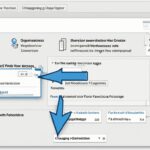Table of Contents
Are you looking to update the favicon on your WordPress website? In this guide, we will walk you through the steps required to change the favicon and give your site a fresh look. The favicon, a small icon that appears next to your website title in browser tabs and bookmarks, plays a crucial role in enhancing your site’s brand identity and recognizing it by visitors.
Changing the favicon can be a quick and straightforward process that can make a significant impact on your website’s overall branding and user experience. Follow the instructions below to update your site’s favicon in a few simple steps.
Key Takeaways
- Changing the favicon can enhance your website’s brand identity and recognition.
- The favicon is a small icon that appears in browser tabs and bookmarks.
- Updating the favicon involves selecting a new favicon, uploading it to your WordPress site, and verifying the change.
- Choose a favicon design that aligns with your brand and optimize it for better performance.
- Check that the new favicon appears correctly in different browsers and devices.
Understanding Favicons
Before we dive into the process of changing the favicon, it is essential to understand the significance of favicons. A favicon is a small icon that appears next to the website title in browser tabs and bookmarks. It may seem like a minor detail, but it plays a crucial role in your website’s overall branding and user experience.
First and foremost, a favicon helps enhance your website’s brand identity. It serves as a visual representation of your brand, allowing users to easily recognize and remember your website. By incorporating your logo or a distinctive symbol, you can create a consistent visual identity that reinforces your brand’s message.
Moreover, favicons contribute to a positive user experience. When users have multiple tabs open, a favicon helps them quickly identify your website among others. It also adds professionalism to your site, making it appear more polished and trustworthy.
To ensure you make the most of your favicon, it’s important to follow some best practices for design. Your favicon should be simple yet impactful, taking into consideration the limited space it occupies. Avoid clutter or excessive detail that might be difficult to discern at such a small size. Additionally, aim for a favicon that reflects your brand’s colors, typography, and overall aesthetics, maintaining consistency across all touchpoints.
Remember, a well-designed favicon can make a lasting impression and elevate your website’s overall appeal. Now that we understand the importance of favicons and best practices for their design, let’s move on to choosing the right favicon for your website.
Favicon Design Best Practices
- Keep it simple and impactful.
- Avoid excessive detail or clutter.
- Reflect your brand’s colors and aesthetics.
- Ensure consistency across all branding touchpoints.
Choosing a New Favicon
Selecting a new favicon for your website is a critical step in maintaining a consistent brand image and improving user recognition. In this section, we will guide you through the process of choosing a suitable favicon that aligns perfectly with your brand identity. Additionally, we will discuss the recommended file format for favicons and offer tips on optimizing them for better performance.
When selecting a new favicon, it’s important to consider the following factors:
- Relevance to your brand: Choose a favicon that represents your brand’s values, products, or services. It should reflect your company’s identity and instantly resonate with your target audience.
- Simplicity and clarity: Opt for a favicon that is simple, easy to recognize, and visually appealing. Avoid complex designs or excessive details as they can become unclear and lose their impact when displayed in smaller sizes, such as in browser tabs or bookmarks.
- Consistency across platforms: Ensure that your chosen favicon looks consistent across different browsers and devices, maintaining its quality and visual appeal. Test it on various platforms to ensure a seamless user experience.
Recommended File Format for Favicons
The file format you choose for your favicon can have an impact on its quality and performance. The most common and recommended file format for favicons is .ico (Icon). This format is supported by most browsers and allows for optimal display in different sizes.
While .ico is the preferred format, modern browsers also support other common image formats such as .png (Portable Network Graphics) and .svg (Scalable Vector Graphics). However, it’s important to note that these formats may not offer the same level of compatibility and flexibility as .ico.
Optimizing Favicons for Better Performance
To ensure optimal performance and faster loading times, it’s essential to optimize your favicon. Consider the following tips:
- Size optimization: Keep your favicon file size as small as possible without compromising its quality. This will help reduce page load times and improve overall user experience.
- Cache headers: Set appropriate cache headers for your favicon to ensure it is cached by the browser, reducing the need to reload it every time a user visits your site.
By following these guidelines for choosing and optimizing your favicon, you can enhance your website’s branding and improve user recognition. Now that you understand the importance of selecting the right favicon, let’s move on to the next section, which focuses on uploading the new favicon to your WordPress site.
![]()
Uploading the New Favicon
Once you have selected a new favicon for your WordPress site, the next step is to upload it using the WordPress dashboard. Follow these simple steps to upload your new favicon:
- Login to your WordPress admin area.
- Navigate to the “Appearance” tab in the left-hand menu and click on “Customize”.
- In the WordPress Customizer, locate and click on the “Site Identity” option.
- In the Site Identity settings, you will find an option to upload your favicon. Click on the “Select Image” button.
- Choose the favicon image file from your computer and click “Open” to start the upload process.
- Wait for the upload to complete, and then click on the “Save & Publish” button to apply the changes.
By following these steps, you can easily upload your new favicon and update the site icon. The site icon is a more recent feature in WordPress that allows you to set the favicon directly from the customizer. Now, your website will have a visually appealing and professionally branded favicon that represents your brand identity.
If you’re having trouble finding the “Site Identity” option in the Customizer or encountering any issues during the upload process, refer to the WordPress documentation or seek help from the WordPress community.
Remember, a well-designed and distinctive favicon can enhance your website’s overall look and make it more recognizable to visitors. Take this opportunity to align your branding with a visually appealing favicon that sets you apart from the competition.
Verifying the Favicon Change
After uploading your new favicon, it’s essential to ensure that the change has been successfully implemented. Follow these steps to check if the updated favicon is appearing correctly in different browsers and devices:
-
Open your website in various web browsers such as Google Chrome, Mozilla Firefox, Safari, and Microsoft Edge.
-
Look for the tab displaying your website’s name. The favicon should appear next to the tab title.
-
If the favicon is not visible, try refreshing the page or clearing your browser cache.
-
Check the favicon’s appearance on different devices, including desktops, laptops, tablets, and mobile phones.
If you find that the favicon is not appearing correctly, it may be due to some common issues. Let’s explore these issues and how to troubleshoot them:
-
Incorrect favicon file format: Ensure that your favicon is saved in the correct file format. Favicon images should be in ICO or PNG format.
-
Inconsistent favicon file name or location: Verify that the favicon file is named “favicon.ico” or “favicon.png” and is placed in the root directory of your website.
-
Caching issues: Clear your browser cache and refresh the page to see if the favicon appears correctly.
-
Favicon size and dimensions: Make sure that your favicon meets the recommended size and dimensions. A standard favicon size is 16×16 pixels or 32×32 pixels.
“A well-designed favicon not only enhances your website’s visual appeal but also contributes to a cohesive brand identity. Make sure to double-check the favicon’s appearance across different browsers and devices to ensure a consistent and professional user experience.”
By carefully verifying the favicon change and resolving any issues that may arise, you can guarantee that your website successfully displays the updated favicon, improving its branding and user experience.
Common Favicon Issues and Troubleshooting Steps
| Issue | Troubleshooting Steps |
|---|---|
| Incorrect favicon file format | Save the favicon in ICO or PNG format |
| Inconsistent favicon file name or location | Ensure the favicon file is named “favicon.ico” or “favicon.png” and placed in the website’s root directory |
| Caching issues | Clear the browser cache and refresh the page |
| Favicon size and dimensions | Check that the favicon meets the recommended size (16×16 or 32×32 pixels) |
Updating Favicons for Different Themes and Plugins
In this section, we will discuss how to update favicons for various WordPress themes and plugins. Different themes and plugins may have their own settings for managing the favicon, so we will guide you on where to find these settings and update the favicon accordingly. Whether you are using a popular theme or a specific plugin, we will provide you with general instructions that can be applied to most cases.
Updating Favicons in WordPress Themes
When it comes to updating favicons in WordPress themes, the process may vary depending on the theme you are using. Here are the general steps to follow:
- Access the WordPress dashboard of your website.
- Navigate to the “Appearance” or “Theme Options” section.
- Look for a tab or option related to “Favicon” or “Site Icon.”
- Upload your new favicon image using the provided field or button.
- Save your changes and visit your website to verify the favicon update.
Keep in mind that the steps mentioned above are generic, and the actual locations of the favicon settings may differ based on the theme you are using. It’s best to consult the theme documentation or contact the theme developer for theme-specific instructions.
Updating Favicons in WordPress Plugins
Updating favicons in WordPress plugins follows a similar principle as updating them in themes. However, the steps may vary based on the plugin you are using. Here is a general approach to update favicons in WordPress plugins:
- Access the WordPress dashboard of your website.
- Go to the “Plugins” section and find the plugin you want to update the favicon for.
- Click on the plugin’s settings or options.
- Look for a tab or option related to “Favicon” or “Site Icon.”
- Upload your new favicon image using the provided field or button.
- Save your changes and visit your website to verify the favicon update.
Remember that the steps outlined above are general guidelines, and the actual locations of the favicon settings may vary for different plugins. If you encounter any difficulties, refer to the plugin’s documentation or reach out to the plugin developer for specific instructions.
Refer to the image above for a visual representation of the favicon update process in WordPress themes and plugins.
In the next section, we will discuss how to check if the favicon update has been successful and address any potential issues that may arise during the process.
Conclusion
In conclusion, changing the favicon on your WordPress website is a simple yet effective way to enhance your site’s branding and improve user experience. By following the steps outlined in this guide, you can easily update the favicon and ensure that it aligns with your overall brand identity. Remember that a well-designed favicon can contribute to a more professional and memorable online presence.
FAQ
How do I change the favicon on my WordPress website?
To change the favicon on your WordPress website, follow these steps:
1. Log in to your WordPress admin dashboard.
2. Go to Appearance > Customize.
3. In the customizer, click on “Site Identity.”
4. Look for the “Site Icon” or “Favicon” option and click on it.
5. Upload your new favicon image or select an existing image from your media library.
6. Save the changes, and your new favicon will be applied to your website.
Why are favicons important for a website?
Favicons are important for a website for several reasons. Firstly, they enhance the overall branding of a website by visually representing the site in browser tabs and bookmarks. Secondly, favicons provide a more professional and polished look to the website. Lastly, they improve user experience by making it easier for visitors to recognize and distinguish the website among multiple open tabs.
How do I choose a suitable favicon for my website?
When choosing a new favicon for your website, consider the following guidelines:
1. Keep it simple and recognizable, as favicons are small and should be easily identifiable.
2. Align the design with your brand identity to maintain consistency.
3. Test the favicon at different sizes to ensure it remains legible.
4. Consider using a square image with a transparent background for optimal compatibility.
Can I change the favicon directly from the WordPress customizer?
Yes, if you have a newer version of WordPress, you can change the favicon directly from the customizer. Simply go to Appearance > Customize, click on “Site Identity,” and look for the “Site Icon” or “Favicon” option. From there, you can upload or select a new favicon image.
How can I check if the new favicon is appearing correctly?
To verify that the new favicon is appearing correctly, follow these steps:
1. Open your website in different browsers, such as Chrome, Firefox, and Safari.
2. Open your website on various devices, such as desktop, tablet, and mobile.
3. If the new favicon is not appearing, try clearing your browser cache and refreshing the page.
4. If the issue persists, double-check that the favicon file is in the correct format (e.g., .ico, .png) and has been uploaded correctly to your WordPress backend.
How do I update the favicon for different WordPress themes and plugins?
The process of updating favicons can vary depending on the WordPress theme or plugin you are using. Here are general instructions:
1. Check the theme or plugin documentation for specific instructions on changing the favicon.
2. Look for the “Customize” or “Theme Options” section in the WordPress dashboard to access the favicon settings.
3. If the theme or plugin does not have built-in favicon support, you can manually update the favicon by replacing the existing favicon file in the theme or plugin folder with your new favicon file.











